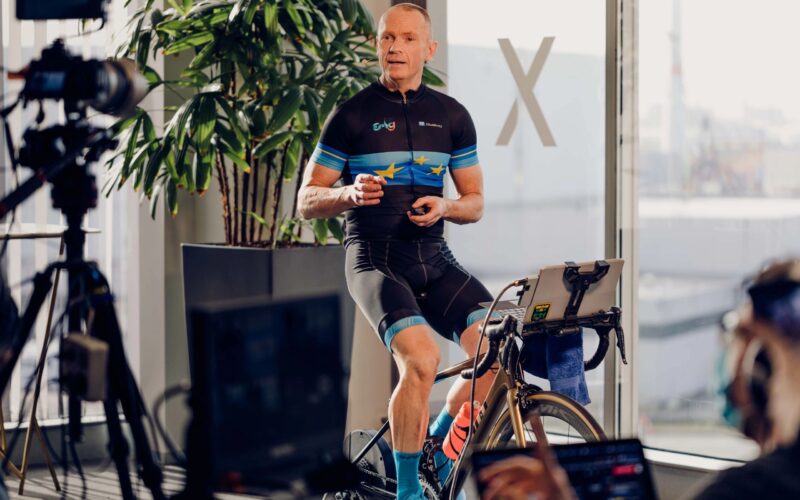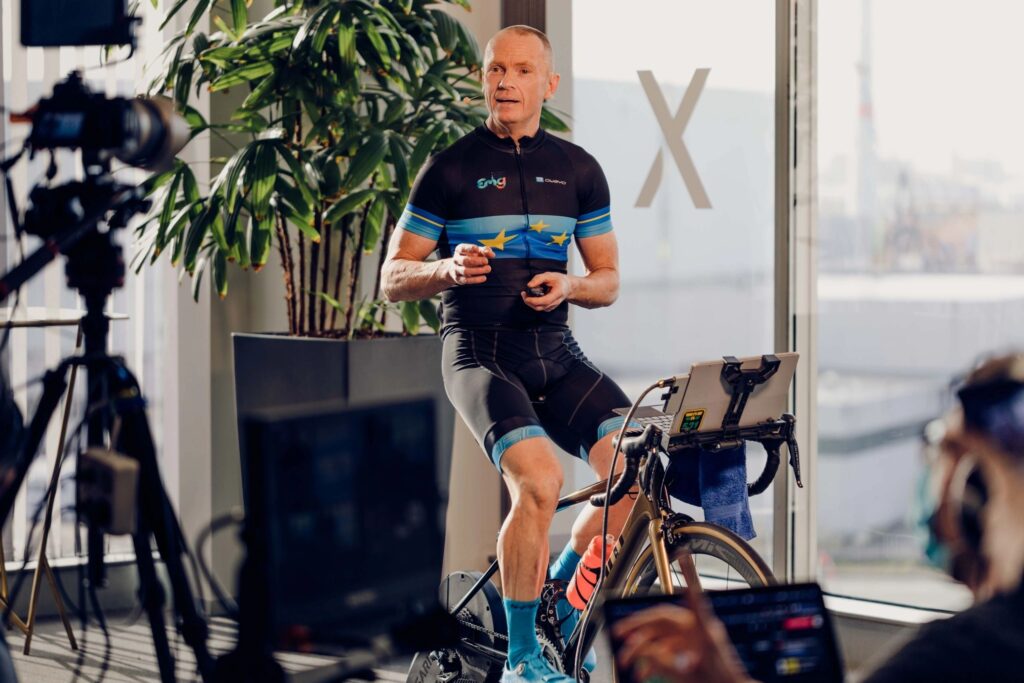You should try indoor cycling while working and boost your productivity
I love hearing about how people use cycling in their everyday lives so when I found Professor Jamie Anderson who advocates indoor cycling while working I wanted to know more. Fellow Aussie Jamie Anderson now calls Belgium home and he’s done some really interesting research about how we can all become healthier and more productive by combining work and exercise. According to Jamie, the science behind brain performance demonstrates that it’s completely possible to combine exercise with certain work tasks, thereby achieving both productivity and improved health and wellbeing.
So I asked Jamie to tell me more via an email interview. If you want to learn more about Jamie you should watch his TED talk or view his Biking Brain keynote talk, or you can book into his hotel in Belgium – The Flandrien Hotel.
Q: How does a Professor of Leadership and Strategy come to become an advocate of riding a bike while working?
I have been doing research and teaching in the field of Creativity & Innovation Management for more than ten years. But it was only after I started to immerse myself in the neuroscience literature a few years ago that I started to understand the impact of brain health upon cognitive performance. It is well understood that exercise has a significant and positive effect on brain health, but nobody had really explored the idea of combining exercise and working at the same time, and how this might contribute to both better health and increased productivity.
So my research is pioneering in many ways and has attracted a huge amount of attention which I think in big part is due to the experience of the Corona pandemic that has forced people to adopt new ways of working.
Q: What does your research indicate about the benefits of riding while working? Does the same benefit apply to other forms of stationery exercising?
Besides the general benefits to fitness and wellbeing, aerobic exercise releases brain-derived neurotrophic factor. This protein promotes the survival of nerve cells (neurons) by playing a role in the growth, maturation (differentiation), and maintenance of these cells. In the brain, the BDNF protein is active at the connections between nerve cells (synapses), where cell-to-cell communication occurs. The synapses can change and adapt over time in response to experience, a characteristic called synaptic plasticity. The BDNF protein helps regulate synaptic plasticity, which is important for learning and memory.
Other beneficial chemicals released during exercise include dopamine and noradrenaline which play important roles in executive functions, motor control and motivation. So if you really want to perform at your cognitive best, then exercise is not a luxury – it is a necessity.
Other aerobic exercise such as running, swimming and rowing have similar benefits. But Indoor cycling is kind of unique when compared to other sports as it permits us to multi-task – it does not require the same motor coordination as other aerobic exercises such as running or swimming, and you can’t take your laptop into a pool!
Q: When did you start riding your bike while working?
I have been doing it for around five years. The winters here in Belgium can be pretty cold and miserable, so I have always used the indoor trainer. At first I used my time on the indoor bike to watch TED Talks, read academic papers and grade the work of my students. But over time I learned that there were many, many more possibilities and now I even engage in calls and webinars with colleagues and customers while on my indoor trainer.
Q: When did you start cycling? What do you love about it?
I’ve been racing my bike since I was nine years old! I raced National level as a junior in Australia, but took a 20 year hiatus away from the sport for my tertiary education, career and family. I returned to cycling at age 40, and over the past decade have podiumed at the National, European and World Masters level. I just love riding my bike, and for me the intensity of emotion experienced when racing at the highest international level just can’t be matched. And I’m about to take my next big step – I will soon open a boutique cycling hotel in the Flemish Ardennes called the “Flandrien Hotel” which is the realisation of a lifelong dream.
Q: Where did you grow up, and how did you come to settle in Belgium?
I grew up in a small town called Shepparton in the bush in the south-east of Australia. I moved to London for work in 1999, and met my Belgian wife while on holiday in Morocco. We settled in Belgium in 2010 and have three Flemish-Australian bilingual kids aged 14, 16 and 18. Belgium is a true cycling paradise in every sense of the word – biking is more like a religion than a sport here in Flanders. The cycling infrastructure is amazing, and from June-September it is possible to race four or five times a week – even as a Masters rider.
Q: What tips would you give to someone who’s got an indoor trainer and works from home but has never combined the two?
Just do it – don’t be afraid of people’s opinions and don’t ask for permission from your boss. I’m constantly amazed by the positive responses that I receive when joining webinars and conference calls from my bike. The typical response of people is “Why didn’t I think of that.” My Keynote talk the “Biking Brain” has launched a movement of people who are now engaging in the practice of cycling & working at the same time. I am constantly receiving photos, videos and stories from people about their own experiences – many of which I share via my LinkedIn posts.
Jamie also put me in touch with a couple of women who are using indoor cycling while working and making family and friends phone calls. Ayesha Mueller tells her story via a LinkedIn post and video here. She also answered a few questions for me via email.
Ayesha said “I am totally fascinated by Jamie’s research.
“Winters in Germany are so cold, that I do not cycle outdoors. This led me to buy a trainer about three years ago, to try and keep fit during these phases. But once I started my PhD, finding the time became really challenging.
“When I watched Jamie’s video a few weeks ago it inspired me to unpack my trainer once again and bring it into the living room. (My husband is also really supportive and encouraged me to do so.) I wasn’t sure how well Jamie’s method would work for me, but I thought, if I don’t try it out I’ll never know. So the first attempt I made was while watching an interview on ecological practices in urban planning. It worked so well! Off-course I had to test a bit, about how loud my laptop needs to be, where I can place it, etc. But it was all worth it.. because surprisingly, the distraction of working while exercising actually makes training itself easier and more fun.
“I used to struggle with motivating myself to get on the trainer (because it’s quite boring), but that isn’t the case anymore. Last time, I rang my brother while on the trainer, after about 15 minutes he said ‘Okay, so I guess you have to get back to work now’. But I said ‘No no, go on, I have time’. He was quite surprised and happy, that I suddenly had more time to listen.
“So I guess what I’m trying to say is, it’s not something I’m going to give up anytime soon. It’s also the reason I made the video; because I truly believe it could help many other people with limited time, as it did me.”


